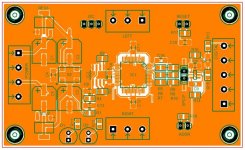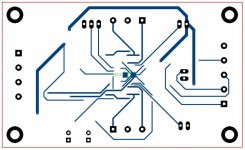Russ White said:Hi Dustin,
Thanks for you answers so far.
A couple questions:
1) When is a reset required?
2) Can the chip change input formats on the fly? Say from PCM to SPDIF or DSD? If so is a reset required?
Thanks!
Russ
Russ White said:One more question, I am thinking I should leave XO(pin 23) open (NC) when using an oscillator for clock input?
Thanks!
Russ
1. reset is not really required at all. You can do a chip reset if it somehow get into a wierd state (im speculating) but I've never seen the need for it yet.
2. Yes chip can change on the fly. I would mute the dac's, then change the source, then unmute for a nice smooth transition
3. Yes you can leave XO floating when connecting to an OSC
Hi Dustin,
If I use an external clock source for the ES9008 DAC, does the clock frequency have an effect on the performance of the DAC?
The datasheet says the external clock must be >192 x Fs, so for a 44.1KHz input, I'd need a clock of at least 8.4672MHz.
The reason I ask is the phase noise of clock oscillators degrades with increasing frequency. If you compare a 10MHz and a 20MHz oscillator from the same device family, same manufacturer, the 10MHz has noticably lower phase noise than the 20Mhz, by up to 10dB! (See this datasheet for example)
http://www.rakon-europe.co.uk/pdf/cfpt-5300.pdf
So if the ES9008 is flexible with its master clock, would I be correct in saying the best performance would be from choosing the lowest possible external clock?
Was thinking 10MHz as this is *the* standard oscillator frequency, available off the shelf for all types of oscillators, right from the cheeziest 40c TTL oscillator, right up to several $100 OCXOs
thanks,
Len.
If I use an external clock source for the ES9008 DAC, does the clock frequency have an effect on the performance of the DAC?
The datasheet says the external clock must be >192 x Fs, so for a 44.1KHz input, I'd need a clock of at least 8.4672MHz.
The reason I ask is the phase noise of clock oscillators degrades with increasing frequency. If you compare a 10MHz and a 20MHz oscillator from the same device family, same manufacturer, the 10MHz has noticably lower phase noise than the 20Mhz, by up to 10dB! (See this datasheet for example)
http://www.rakon-europe.co.uk/pdf/cfpt-5300.pdf
So if the ES9008 is flexible with its master clock, would I be correct in saying the best performance would be from choosing the lowest possible external clock?
Was thinking 10MHz as this is *the* standard oscillator frequency, available off the shelf for all types of oscillators, right from the cheeziest 40c TTL oscillator, right up to several $100 OCXOs
thanks,
Len.
len_scanlan said:Hi Dustin,
If I use an external clock source for the ES9008 DAC, does the clock frequency have an effect on the performance of the DAC?
The datasheet says the external clock must be >192 x Fs, so for a 44.1KHz input, I'd need a clock of at least 8.4672MHz.
The reason I ask is the phase noise of clock oscillators degrades with increasing frequency. If you compare a 10MHz and a 20MHz oscillator from the same device family, same manufacturer, the 10MHz has noticably lower phase noise than the 20Mhz, by up to 10dB! (See this datasheet for example)
http://www.rakon-europe.co.uk/pdf/cfpt-5300.pdf
So if the ES9008 is flexible with its master clock, would I be correct in saying the best performance would be from choosing the lowest possible external clock?
Was thinking 10MHz as this is *the* standard oscillator frequency, available off the shelf for all types of oscillators, right from the cheeziest 40c TTL oscillator, right up to several $100 OCXOs
thanks,
Len.
Hi Len,
We hanven't notived any significant difference between ocsillator frequencies. My prefference would be to use a fast one over a slower one simply becuase it pushes the quantization noise further out of band. I know I might get flamed over this one in this forum, but everyone needs an opinion.
Thanks
Dustin
Does this look sane?
Hi Dustin, Here is my schematic for the DAC PCB.
I have decided to do the controller off board or to utilize my existing "uber controller' board.
But I think it will work great as the default mode is PCM/I2S and I have modules already that output I2S.
The board is for stereo output only.
I/V filtering is done on another PCB which will stack with this one.
Will post PCB pics in a while.
Does the schematic look ok?
Cheers!
Russ
Hi Dustin, Here is my schematic for the DAC PCB.
I have decided to do the controller off board or to utilize my existing "uber controller' board.
But I think it will work great as the default mode is PCM/I2S and I have modules already that output I2S.
The board is for stereo output only.
I/V filtering is done on another PCB which will stack with this one.
Will post PCB pics in a while.
Does the schematic look ok?
Cheers!
Russ
Attachments
Project Buffalo... hmmm ...

On my demo board I connected the I2S to all four inputs.
Dustin described that in a post several pages back. It was the long post about configuring that last register to use 6,7,8,or 9 bit DACs.
When it is in SPDIF mode it autoconfigures for stereo, and you can use it the way you have it on the schematic.
On my demo board I connected the I2S to all four inputs.
Dustin described that in a post several pages back. It was the long post about configuring that last register to use 6,7,8,or 9 bit DACs.
When it is in SPDIF mode it autoconfigures for stereo, and you can use it the way you have it on the schematic.
rossl said:Project Buffalo... hmmm ...

On my demo board I connected the I2S to all four inputs.
Dustin described that in a post several pages back. It was the long post about configuring that last register to use 6,7,8,or 9 bit DACs.
When it is in SPDIF mode it autoconfigures for stereo, and you can use it the way you have it on the schematic.
Yes a name only a hockey fan can truly appreciate.
Ah thanks for that tip, somehow I missed it!
You just need 47K pulldowns on pins 55, 56, and 57. Then put 3 more pins on your digital connector.
Then, if you use SPDIF, you close the SPDIF switch and everything is OK.
If you want I2S, you open the SPDIF switch and connect the stereo I2S data so it goes to all 4 of the pins 55,56,57,and 58.
For DSD you need pulldowns and pins for everything.
Then, if you use SPDIF, you close the SPDIF switch and everything is OK.
If you want I2S, you open the SPDIF switch and connect the stereo I2S data so it goes to all 4 of the pins 55,56,57,and 58.
For DSD you need pulldowns and pins for everything.
rossl said:You just need 47K pulldowns on pins 55, 56, and 57. Then put 3 more pins on your digital connector.
Then, if you use SPDIF, you close the SPDIF switch and everything is OK.
If you want I2S, you open the SPDIF switch and connect the stereo I2S data so it goes to all 4 of the pins 55,56,57,and 58.
For DSD you need pulldowns and pins for everything.
It not so much switching between SPDIF and PCM I am worried about.
Dougie085 said:So your going to have 4 outputs ran to each channel correct? To get the lowest possible noise floor?
Yes.
rossl said:For DSD you need pulldowns and pins for everything.
Yes, I reached the same conclusion, I will probably go that route but I am still trying to think of something more slick. Not sure I can though.
Only thing I can think of is to use some tristate switches.
Cheers!
Russ
- Home
- Source & Line
- Digital Line Level
- ESS Sabre Reference DAC (8-channel)

